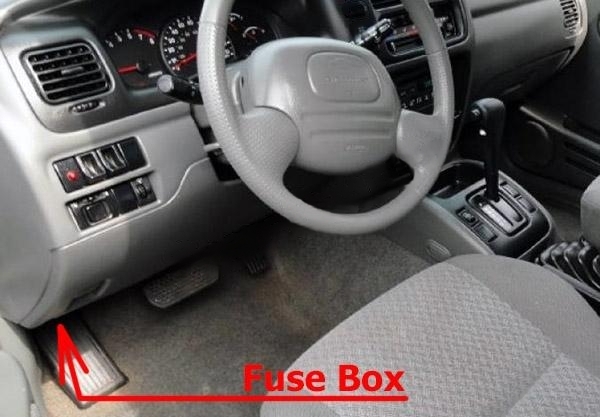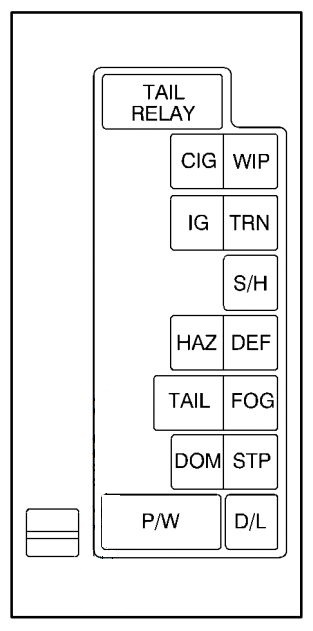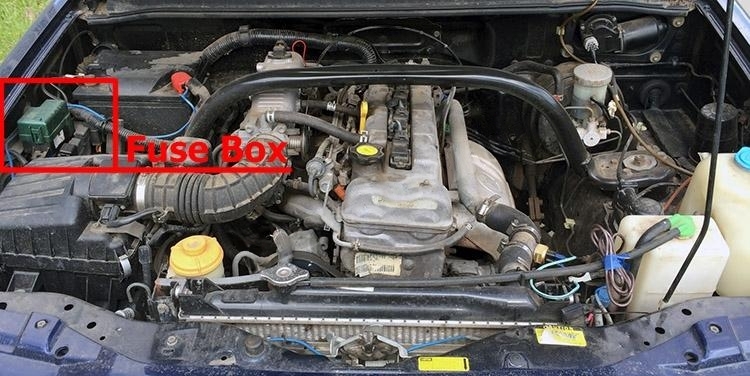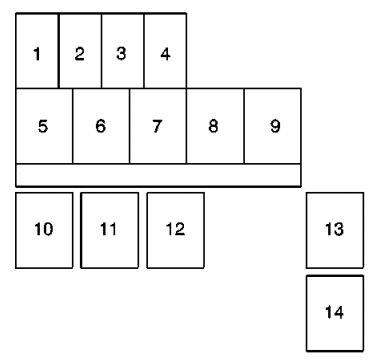Chevrolet Tracker (1999-2004) fuse box and relay Diagrams
The Chevrolet Tracker, produced from 1999 to 2004, is a compact SUV that combines the versatility of a sport utility vehicle with the maneuverability of a smaller car. This vehicle is appreciated for its off-road capabilities and economical performance, making it a popular choice for those seeking a budget-friendly, reliable vehicle. A key component of the Tracker’s operation is its electrical system, where the fuse box and relays play critical roles in maintaining the vehicle’s functionality and safety.
The fuse box in the Chevrolet Tracker is essential for protecting the vehicle’s electrical circuits. These circuits power important systems, including engine management, lighting, climate control, and power accessories like windows and locks. Typically, the Tracker has two main fuse boxes: one located in the engine compartment and another inside the cabin, often found under the dashboard or near the driver’s side footwell. The engine compartment fuse box manages systems related to the engine and other high-power components, while the interior fuse box handles systems related to comfort and convenience.
Each fuse is connected to a specific circuit and is designed to “blow” if there’s an overload or short circuit, thereby preventing potential damage to the circuit and the vehicle’s components. This safety mechanism helps prevent electrical fires and avoids costly repairs. If a system like the headlights or power locks malfunctions, checking the corresponding fuse is a straightforward troubleshooting step.
Relays in the Chevrolet Tracker are electrically operated switches that control the power supply to high-current systems such as the starter motor, fuel pump, and cooling fans. Relays allow these high-demand systems to be managed by lower-power circuits, ensuring the vehicle’s wiring and switches are not overloaded, which promotes safe and efficient operation.
Regular inspection and maintenance of the fuse box and relays in the Chevrolet Tracker are crucial to avoiding electrical problems. A blown fuse or faulty relay can lead to system failures, such as the engine not starting if the starter relay is defective, or overheating issues if the cooling fan relay malfunctions. Ensuring that fuses and relays are replaced with the correct specifications is vital to maintaining the vehicle’s performance.
Understanding the roles of the fuse box and relays helps owners ensure that their Chevrolet Tracker’s electrical system remains reliable. This contributes to the vehicle’s overall dependability and safety, making it a suitable choice for both everyday driving and off-road adventures. Keeping these components in good working order ensures the continued functionality of the Tracker’s various features.
MUST READ: DYI – How to Check Car Fuses?
(1999-2004) Chevrolet Tracker fuse box and relay with Diagram
WARNING
- Never replace a fuse with one that has a higher amperage rating.
- A fuse with a too-high amperage could damage the electrical part and cause a fire.
- On no account should fuses be repaired (e.g. patched up with tin foil or wire) as this may cause serious damage elsewhere in the electrical circuit or cause a fire.
- If a fuse blows repeatedly, do not keep replacing it. Instead, have the cause for the repeated short circuit or overload tracked and fixed.
- Terminal and harness assignments for individual connectors will vary depending on vehicle equipment level, model, and market.
Chevrolet Tracker 1999-2004 fuse assignment
- Cigar lighter (power outlet) fuses in the Chevrolet Tracker are located in the Instrument panel fuse box (see fuse “CIG”) and in the Engine Compartment Fuse Box (see fuses №. 1 and №7).
Year of production: from 1999, 2000, 2001, 2002, 2003, 2004
Instrument Panel Fuse Box
Fuse box location

It is located under the left side of the instrument panel.
Fuse box diagram

Assignment of the fuses in the Instrument Panel
| Name | Usage |
|---|---|
| P/W | Power Windows |
| DOM | 1999-2001: Dome Light 2002-2004: Dome Light, Radio Memory |
| TAIL | License Plate Light, Clearance/Marker Lights, Instrument Panel Illumination, Warning Tone |
| HAZ | 1999-2001: Hazard Lights 2002-2004: Hazard Lights, Turn Signal |
| IG | Oxygen Sensor Heater, Cruise Control, Ignition Coil, Meter, G Sensor |
| CIG | Cigar/Cigarette Lighter, Radio, Power Mirror |
| D/L | Door Locks |
| STP | Brake Light, Horn, Center High-Mounted Stop Lamp, Cruise Control |
| FOG | Not Used |
| DEF | 1999-2001: Rear Window Defogger, DRL 2002-2004: Rear Window Defogger, DRL, Heater, Air Conditioning |
| S/H | Not Used |
| TRN | 1999-2001: Turn Signal, Back-Up Light 2002-2004: Turn Signal, Back-Up Light, Hazard Lights |
| WIP | Windshield Wiper/Washer, Rear Window Wiper/Washer |
| * Fuses for the air bags and the heater/air conditioning system are located next to the instrument panel fuse block |
Engine Compartment Fuse Box
Fuse box location

It is located in the engine compartment on the passenger side (relays are located next to the fuse box).
Fuse box diagram

Assignment of the fuses and relays in the Engine Compartment
| № | Usage |
|---|---|
| 1 | Accessory Power Outlet |
| 2 | Electronic Fuel Injection System |
| 3 | Right Headlamp |
| 4 | Left Headlamp, High-Beam Indicator |
| 5 | Heater |
| 6 | Hazard Lamps, Rear Combination Lamps, Dome Light, Horn |
| 7 | Cigar Lighter, Radio, I.G., Meter, Wiper, Washer, Rear Defroster, Turn Signals, Back-Up Lamps |
| 8 | Anti-Lock Brake System |
| 9 | All Electrical Loads |
| 14 | Air Conditioning |
| Relays | |
| 10 | Shift Lock |
| 11 | Horn (2.5L Engine Only) |
| 12 | Air Conditioning Compressor |
| 13 | Air Conditioning Condenser Fan |
Conclusion
For owners and enthusiasts of classic Chevrolet Tracker 1999-2004, understanding the fuse box and relay systems is essential for vehicle maintenance. Regular inspection and maintenance of these components helped ensure the vehicle’s longevity and reliability, preserving its status as a symbol of Chevrolet’s craftsmanship and innovation in the automotive industry during that era.